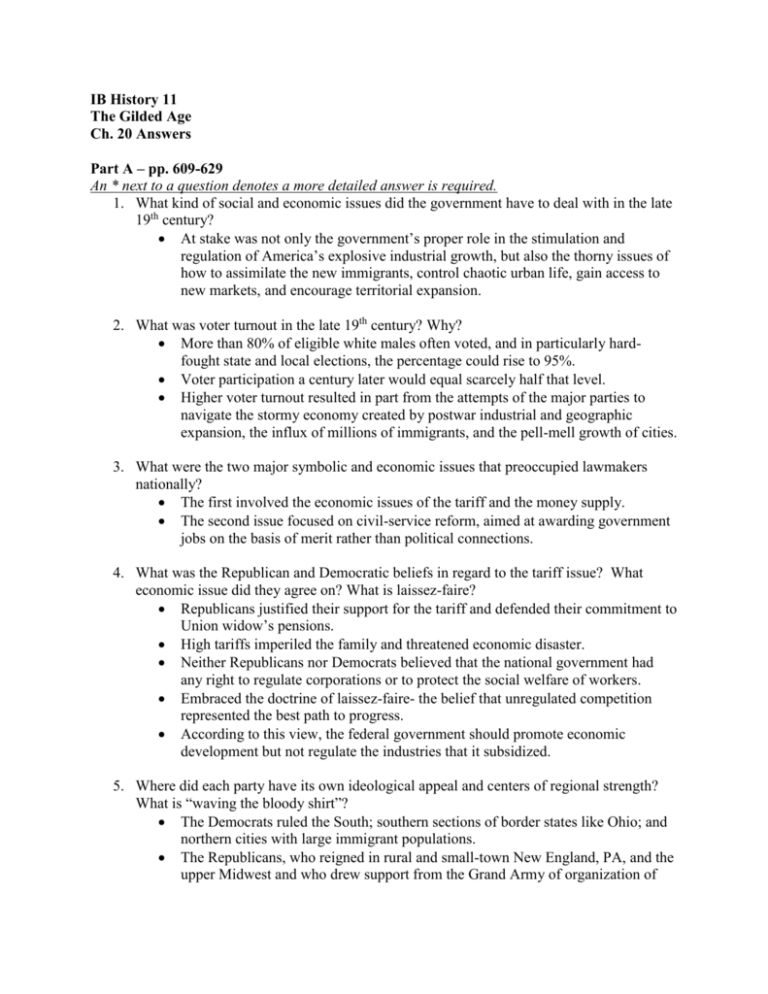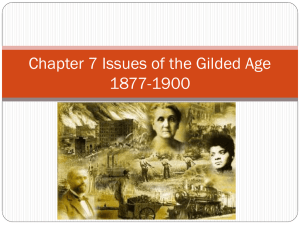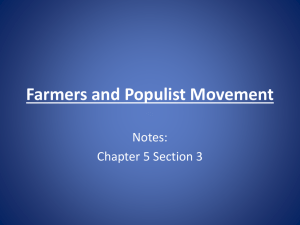File - Mr. Champion`s History Classes
advertisement

IB History 11 The Gilded Age Ch. 20 Answers Part A – pp. 609-629 An * next to a question denotes a more detailed answer is required. 1. What kind of social and economic issues did the government have to deal with in the late 19th century? At stake was not only the government’s proper role in the stimulation and regulation of America’s explosive industrial growth, but also the thorny issues of how to assimilate the new immigrants, control chaotic urban life, gain access to new markets, and encourage territorial expansion. 2. What was voter turnout in the late 19th century? Why? More than 80% of eligible white males often voted, and in particularly hardfought state and local elections, the percentage could rise to 95%. Voter participation a century later would equal scarcely half that level. Higher voter turnout resulted in part from the attempts of the major parties to navigate the stormy economy created by postwar industrial and geographic expansion, the influx of millions of immigrants, and the pell-mell growth of cities. 3. What were the two major symbolic and economic issues that preoccupied lawmakers nationally? The first involved the economic issues of the tariff and the money supply. The second issue focused on civil-service reform, aimed at awarding government jobs on the basis of merit rather than political connections. 4. What was the Republican and Democratic beliefs in regard to the tariff issue? What economic issue did they agree on? What is laissez-faire? Republicans justified their support for the tariff and defended their commitment to Union widow’s pensions. High tariffs imperiled the family and threatened economic disaster. Neither Republicans nor Democrats believed that the national government had any right to regulate corporations or to protect the social welfare of workers. Embraced the doctrine of laissez-faire- the belief that unregulated competition represented the best path to progress. According to this view, the federal government should promote economic development but not regulate the industries that it subsidized. 5. Where did each party have its own ideological appeal and centers of regional strength? What is “waving the bloody shirt”? The Democrats ruled the South; southern sections of border states like Ohio; and northern cities with large immigrant populations. The Republicans, who reigned in rural and small-town New England, PA, and the upper Midwest and who drew support from the Grand Army of organization of northern Civil War veterans, often “waved the bloody shirt,” reminding voters that their party had led the nation during the Civil War. 6. Explain how, outside the South, ethnicity and religion were the most reliable predictors of political affiliation? Catholics, especially Irish Catholics, and Americans of German ancestry tended to vote Democratic. Old-stock northerners, in contrast, including 75% of Methodists and Congregationalists, 65% of Baptists, and 60% of Presbyterians voted Republican. Among immigrant groups, most British-born Protestants and 80% of Swedish and Norwegian Lutherans voted Republican, as did African Americans, North and South. Although intolerant of racial differences, the Democrats were generally more accepting of religious diversity than were the Republicans. 7. Who favored a tight currency supply and who favored expanding the money supply? Why? Bankers and creditors, most business leaders, economists, and politicians believed that economic stability required a strictly limited currency supply. Debtors, especially southern and western farmers, favored expanding the money supply to make it easier for them to pay off their debts. 8. What was advocated by the Greenback party? The Greenback party advocated an expanded money supply, health and safety regulations for the workplace, and other measures to benefit workers and farmers. 9. What is the spoils system? What was its major drawback? For decades successful candidates in national, state, and local elections had rewarded supports and contributors with jobs ranging from cabinet seats and ambassadorships to lowly municipal posts. Unqualified and incompetent applicants often got jobs simply because of their party loyalty. 10. What kind of civil service reform was championed by Senator Carl Schurz and editor E.L Godkin? Godkin of Nation, had campaigned for a professional civil service based on merit. Whatever their class biases, the reformers had a point. A professional civil service was needed as government grew more complex. 11. What happened to President James Garfield in 1881? Garfield’s assassination was in 1881. 12. Describe the Pendleton Act? The Pendleton Civil Service Act set up a commission to prepare competitive examinations and establish standards of merit for a variety of federal jobs; it also forbade political candidates from soliciting contributions from government workers. 13. Who were the Mugwumps? Reformers 14. What did tariffs do for the federal government? Tariff duties were a major source of revenue in the era before a federal income tax, so the tariff was really a form of taxation. 15. Who favored high tariffs and who disliked high tariffs? Why? The producers of such commodities as coal, hides, timber, and wool demanded tariff protection against foreign competition, and industries that had prospered behind tariff walls-iron and steel, textiles, machine tools-wanted protection to continue. Many workers in these industries agreed, convinced that high tariffs meant higher wages. Other manufacturers, however, while seeking protection for their finished products, wanted low tariffs on the raw materials they required. MA shoe manufacturers, for example, urged high duties on imported shoes but low duties on imported hides. Most farmers, by contrast, hated the protective tariff, charging that it inflated farm-equipment prices and, by impeding trade, made it hard to sell American farm products abroad. 16. Why did President Cleveland dislike the budget surpluses created by the high tariffs? These surplus tempted legislators to distribute the money in the form of veterans’ pensions or expensive public-works programs, commonly called pork-barrel projects, in their home districts. With his horror of paternalistic government, Cleveland viewed the budget surplus as a corrupting influence. 17. Why did President Cleveland take on the GAR (Grand Army of the Republic)? Veterans’ disability pensions cost the government millions of dollars annually. No one opposed pensions for the deserving, but by the 1880s fraudulent claims had become a public scandal. In 1887 he vetoed a bill that would have pensioned all disabled veterans and their dependents. The pension list should be an honor roll, he declared, not a refuge for frauds. 18. Who won the election of 1888? Why? Despite such chicanery, Cleveland got almost a hundred thousand more votes than Harrison. But Harrison carried the key states of Indiana and New York and won in the Electoral College. 19. Why did the pension system become America’s first large-scale public welfare program? Over 1 million enrolled 20. *What was the main purpose of the Grange Movement? How did the Grangers seek to restore self-sufficiency to the family farmer? What were its successes and failures? An 1874 circular announced the organization’s primary purpose: to help farmers “by less and produce more, in order to make our farms more self-sustaining.” Ignoring the contradiction in farmers’ banding together to help individuals become more independent, they negotiated special discounts with farm-machinery dealers and set up “cash-only” cooperative stores and grain-storage elevators to cut out the “middlemen”-the bankers, grain brokers, and merchants who made money at their expense. Grangers vehemently attacked the railroads, which routinely gave discounts to large shippers, bribed state legislators, and charged higher rates for short runs than for long hauls. The railroads appealed to the Supreme Court to declare these “Granger laws” unconstitutional. But in Munn v. Illinois the Court not only rejected the railroads’ appeal but also upheld an Illinois law setting a maximum rate for the storage of grain. Interstate Commerce Act, reaffirming the federal government’s power to investigate and oversee railroad activities and establishing a new agency, the Interstate Commerce Commission, to do just that. 21. *How valid was the Grangers’ analysis of the farmers’ problems? 1873-1878 the entire economy was in depression between 1865-1900 commodity prices fell as well as wholesale manufactured goods the railroads stiff freight prices could be justified in part by the scarcity of western settlement and the seasonality of grain shipments farmers who had no control over the price of their crops were at the mercy of the equipment dealers who controlled what they charged railroads would sometimes transport wheat to only one mill and some railroads would refuse to stop at small towns to pick local wheat shipments conclusion: yes, the farmers were at the mercy of the railroads and merchants, but they too had a right to try to survive during tough economic times 22. What situation did small farmers find themselves in the South? Trapped by the crop-lien system, mortgaging future harvests to cover current expenses 23. *How did the Farmers’ Alliance Movement begin? What two groups emerged as a result of the Alliance Movement? Briefly describe the boom and bust between 1880 and 1897. The farmer alliance began in Texas in the late 1870’s as poor farmers gathered discuss their hardships. By 1889, Macune had merged several regional organizations into the National Farmers’ Alliance and Industrial Union, or Southern Alliance. A parallel black organization, the National Colored Farmers’ Alliance, had meanwhile emerged in Arkansas and spread to other southern states. But the protests spirit faded as renewed rainfall revived confidence and lured thousands of settlers to the northern plains. The boom triggered frenzied land speculation. In 1886-1887 the drought returned. From 1887 to 1897, only two great plains wheat crops were worth harvesting. Searing winds shriveled the half-ripe as locusts and chinch bugs gnawed away the rest. To make matters worse, wheat prices fell as world production increased. 24. What were the political objectives of the Alliance Movement in 1889-90? Their objective which focused on increasing government action on behalf of farmers and workers, included tariff reduction, a guaranteed income tax, public ownership of the railroads, federal funding for irrigation research, a ban on landownership by aliens, and “the free and unlimited coinage of silver” 25. What political party emerged in 1892? What was its platform? In February 1892 alliance leaders organized the People’s Party of the United States, generally called the Populist Party. The Populist party’s platform restated the alliance goals while adding a call for the direct popular election of senators and other electoral reforms. It also endorsed a plan devised by the alliance leader Charles Macune by which farmers could store their nonperishable commodities in government warehouses, receive low interest loans using crops as collateral, and then see the stored commodities when market prices rose. 26. How were blacks systematically disenfranchised in the South after Reconstruction? Intimidation, terror, vote fraud---Mississippi amended its state constitution in ways that effectively excluded blacks from voting Indirect exclusions – literacy tests, poll taxes, and property requirements However, the grandfather clause exempted anyone who had an ancestor that voted in 1860 from these requirements 27. *Describe the system of white supremacy that was erected in the South; specifically, the convict-lease system and lynching. States passed laws imposing strict racial segregation Convict-lease system – employers could “lease” prison gangs and force them to work under slave labor conditions The convict-lease system brought revenue to state government s and provided cheap labor for factories, railroads, farms, etc… Thousands died in the convict-labor system Hundreds of blacks were lynched annually in the United States; 80% of lynchings included black citizens Lynchings tended to peak during times of economic distress when competition between poor whites and blacks was most intense NOTE: Southern agrarian protest and white racism- a case where agrarian gains became secondary to race; white Southerners would not accept blacks in Populist leadership positions; the backlash probably worsened conditions for blacks- the federal government stood by and did nothing 28. How did the Civil Rights Cases (1883) and *Plessy v. Ferguson (1896) affect the African American population and other ethnicities in the United States? Civil Rights cases – the 14th Amendment only protected citizens from government infringement of their rights, NOT from acts by private citizens Plessy v. Ferguson – racial segregation was constitutional if equal facilities were provided to each race The South segregated its schools as a result of the Plessy decision; however, the facilities and conditions were not equal. Plessy affected blacks nationwide, Mexicans in Texas, Asians in California 29. Describe the background and the message of Booker T. Washington. Born into slavery, attended a Freedman’s school, organized a black technical school in Alabama that became Tuskegee University Secretly contributed to those who challenged segregation, but his public message was accommodation to a racist society He insisted that the first task of blacks was to attain useful skills such as farming or carpentry. Once blacks proved their economic value, he predicted, racism would fade; meanwhile, they must patiently accept their lot Up From Slavery – he recounted his rise from poverty thanks to honesty, hard work, and kindly patrons. 30. What was the policy toward blacks for the Knights of labor and the American Federation of Labor? Using your own knowledge, why is this not surprising? KOL welcomed blacks and had 60,000 members by 1880’s AFL officially forbade racial discrimination, but n practice many of its member unions excluded blacks ???? 31. What were the political implications of the solid South? Made a mockery of the two-party system in the South-----You had to be a Democrat to win in the South. Why?????? The large bloc of Democrats from the southern state moved quickly to block any legislation that would threaten southern white supremacy Southern Democrats wielded enormous clout in the national party. No candidate who was unacceptable to them stood a chance of winning the Democratic nomination 32. Who won the election of 1892? Why? Grover Cleveland A public reaction against labor violence and the McKinley Tariff hurt Harrison, while Cleveland’s support for the gold standard won conservative business support 33. How did the Populists fare in the election? Received just over 1 million votes = 8.5% of the total Elected 5 senators, 10 congressmen, and 3 governors The party made no dent in New England, the urban East, or the traditionally Republican farm regions of the Midwest, and failed to show broad strength in the upper Great Plains 34. How did the railroads fuel the economic boom of the 1880’s? They fed the speculative mania by issuing more stock (and enticing investors with high dividends) than their businesses warranted 35. What were the reasons for the diminished confidence the gold standard? When a London investment bank collapsed, hard-pressed British investors sold millions of dollars of railroad stock and converted their dollars to gold, draining US gold reserves Congress’ lavish veteran’s benefits and pork barrel spending drained government resources just as tariff revenues were dropping because f the high McKinley tariff The Sherman Silver Purchase Act further strained gold reserves---monthly silver purchases were paid with treasury certificates which were redeemable in silver or gold and many certificate holders chose gold The election of Grover Cleveland in 1892 eroded confidence because his party harbored advocates of inflationary policies 36. How did the collapse of the railroads in early 1893 trigger the Panic of 1893? Fear fed on itself and panicky investors converted their stock holdings into gold Stock prices plunged and gold reserves sank 74 railroads and 15,000 commercial institutions, including 600 banks, had failed 37. What was Jacob Coxey’s solution for the unemployment problem? What was Coxey’s Army? $500 million public works program funded with paper money not funded by gold but simply designated as legal tender he organized a march on Washington and thousands joined him in route (Coxey’s Army) 38. How was President Grover Cleveland able finally able to stop the gold drain and restore confidence in the government’s economic stability? Borrowed $62 million from JP Morgan and August Belmont in exchange for US bonds at a special discount The government then purchased gold to replenish its reserves 39. What was imposed for the first time by the Wilson-Gorman Tariff? What was the outcome of Pollock v. Farmers’ Loan & Trust Co.? 2% income tax Supreme Court ruled the law unconstitutional 40. What were the positions of the gold supporters and the silver supporters? Gold supporters recognized that paper money need to be back by something or the result would be devastating inflation Silver supporters understood how tight money policies depressed prices and devastated farmers 41. Who were the Democratic and Republican nominees for president in 1896? What kind of campaigns did each candidate run? Republicans – William McKinley – front-porch campaign – posters, pamphlets, newspaper articles and a $7 million war chest Democrats – William Jennings Bryan – crisscrossed the nation delivering hundreds of speeches 42. Why did William Jennings Bryan lose the election of 1896? limited core constituency - the platform and candidate had little appeal to the factory workers, urban middle class, and Midwest farmers – city dwellers didn’t want to pay higher prices – a little too Protestant 43. How did the McKinley administration quickly translate its conservative platform into law? The Dingley Tariff pushed rates to an all-time high The Currency Act of 1900 officially committed the US to the gold standard








